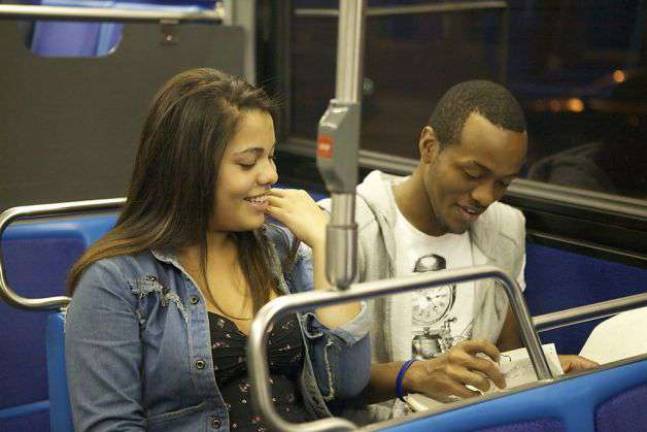Back of the Bus, Top of the Heap

Michel Gondry's latest ingenuity may be the best teen flick ever
At first Michel Gondry's The We and the I is charming and then it's scary. It starts with a delightfully, deliberately crude F/X of a boom box style city bus traversing the rough streets of The Bronx--a toy-like transformation that gets smashed into realism: An actual city bus opens its doors to rowdy New York kids coming home as high school ends. Despite their varied, awkward traits--jostling, joking, rushing, yelling--each could be the protagonist yet Gondry draws us to the back of the bus. And that's the scary, great part.
As any bus rider knows, the back is where the bullies sit--away from authority, ganged-up, undisciplined and inevitably cruel. They huddle in masculine privilege and unchallenged toughness and Gondry doesn't shy away from it; he gets close--Cassavetes close, Godard intimate. The We and the I indulges a frank, emotional, non-sociological look at the chaos of adolescence.
Gondry is French but he doesn't offer any of the guilty Liberal condescension that was so appalling in Laurent Cantet's The Class about the children of non-white immigrants who are trapped in the boring Paris school system. Instead, Gondry's cast of Black and Latino teens set their own terms of presentation. (The film is a collaboration with students from a Bronx community center.) They are as they unselfconsciously present themselves: natural naifs, punks, dreamers, lovers, clowns and all are amazingly trenchant, believable actors. Imagine the kids of George Washington electrified with urban impudence. Professional actors should be learning from this from now on.
Credit Gondry's openness to the kids' humanity including a keen perception (possibly based on his own memories) of adolescence. They reveal that barely perceptible childhood shift between sadism and vulnerability: When a bully trashes a boy's guitar, a girl gets ridiculed for wearing a wig and an indiscretion at a party, two friends berate each other's insensitivity, the ache of real pain and confusion is palpable and unsettling--credible facts of life being learned.
Gondry's beautiful title conveys the tension of group identity and personal isolation, as in the closing tete a tete between Michael Brodie and Teresa Lynn. It's the universal process of realizing oneself within the experience of socializing--the reason why, emotionally, we never really get out of high school. As boys and girls, shy kids and show-offs mix together, Gondry moves from individuality (a boy drawing in a sketch pad), solipsism (another quietly reading a comic book) to friendship (two girls planning a house party, two gay boys flaunting their freedom, the obnoxious, fractious bullies). Fuctuating tempers, flirtations and anxieties (at least several kinds of each) provide an amazing, at-hand survey of human kind.
Where Spike Lee's 1997 Get on the Bus made political points by contriving an Everymen cast with predictable arguments, The We and the I avoids dramatic convention and predictability. This bus trip is a conceit taking youths from day to a dark night of the soul--recalling the revelations of Time of Your Life, The Iceman Cometh as much as The Breakfast Club yet none of those sober landmarks boasted such fresh, delirious vernacular. Luis Figeroa sighs, "I don't know where the hell the day went wrong. "'Gut feelings' are gay" says the gay kid. Gondry dives into youthful unruliness and keeps up with it through improvisational ingenuity, occasionally featuring both theatrical and video cutaways--all hand-styled like his quaint, joyful, groundbreaking music videos.
Much of the film's excitement owes to its fresh exactitude about how feelings are translated through the media options available for youth's attention and comprehension. Musical instruments, pens, artist's pencils, cell phones and digital cameras become tactile means of the kids' personal expression. Mobile devices are Gondry's ruling metaphor: A boy's pratfall at home caught on video and endlessly circulated runs throughout the film provides a leitmotiv about instant awkwardness and fame via technology.
This isn't Gondry being meta but he's aware of how kids' view of the world (and themselves) is being shaped. As he proceeds, each story gets more personal and more poignant. Teen sass, sensitivity and vulgarity are lovingly observed here; and it's not faddish as proved by Gondry's music track featuring the still-charming, ever-enjoyable Young MC rap hits "Bust a Move" and "I Come Off" from the 1990s.
Miraculously, The We and the I achieves the real-world poignance--the horror of high school--that Robert Mulligan sought in the fine but traditionally constructed Up the Down Staircase. Learning from Cassavetes, Godard, even Altman's California Split, Gondry has made the liveliest, toughest teen movie since Jeff Kreines and Joel DeMott's Seventeen and Joe Cornish's Attack the Block. Gondry's combo verisimilitude and self-dramatization come from the inside (as in the slo-mo fascination with a girl riding a bicycle alongside the bus) like nothing I've ever seen before.
Set at the end of spring semester---on the cusp of adulthood--The We and the I takes on the special hell that "school's out" signifies for every student (as well as every New York straphanger). It's not nostalgic about adolescence but reveals its complexity and that makes it deeper, sweeter--maybe the movie of the year.
Follow Armond White on Twitter at 3xchair